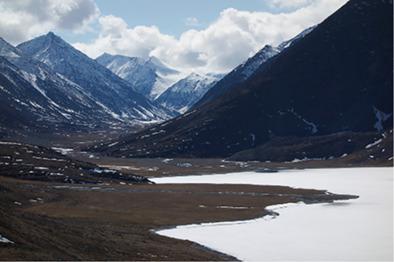当前位置:
X-MOL 学术
›
Hydrol. Process.
›
论文详情
Our official English website, www.x-mol.net, welcomes your
feedback! (Note: you will need to create a separate account there.)
Modelling suspended sediment discharge in a glaciated Arctic catchment–Lake Peters, Northeast Brooks Range, Alaska
Hydrological Processes ( IF 2.8 ) Pub Date : 2020-07-21 , DOI: 10.1002/hyp.13846 Lorna Louise Thurston 1, 2 , Erik Schiefer 1 , Nicholas P. McKay 2 , Darrell S. Kaufman 2
Hydrological Processes ( IF 2.8 ) Pub Date : 2020-07-21 , DOI: 10.1002/hyp.13846 Lorna Louise Thurston 1, 2 , Erik Schiefer 1 , Nicholas P. McKay 2 , Darrell S. Kaufman 2
Affiliation

|
Seasonal suspended sediment transfer in glaciated catchments is responsive to meteorological, geomorphological, and glacio‐fluvial conditions, and thus is a useful indicator of environmental system dynamics. Knowledge of multifaceted fluvial sediment‐transfer processes is limited in the Alaskan Arctic – a region sensitive to contemporary environmental change. For two glaciated sub‐catchments at Lake Peters, northeast Brooks Range, Alaska, we conducted a two‐year endeavour to monitor the hydrology and meteorology, and used the data to derive multiple‐regression models of suspended sediment load. Statistical selection of the best models shows that incorporating meteorological or temporal explanatory variables improves performances of turbidity‐ and discharge‐based sediment models. The resulting modelled specific suspended sediment yields to Lake Peters are: 33 (20–60) t km−2 yr−1 in 2015, and 79 (50–140) t km−2 yr−1 in 2016 (95% confidence band estimates). In contrast to previous studies in Arctic Alaska, fluvial suspended sediment transfer to Lake Peters was primarily influenced by rainfall, and secondarily influenced by temperature‐driven melt processes associated with clockwise diurnal hysteresis. Despite different sub‐catchment glacier coverage, specific yields were the same order of magnitude from the two primary inflows to Lake Peters, which are Carnivore Creek (128 km2; 10% glacier coverage) and Chamberlin Creek (8 km2; 23% glacier coverage). Seasonal to longer‐term sediment exhaustion and/or contrasting glacier dynamics may explain the lower than expected relative specific sediment yield from the more heavily glacierized Chamberlin Creek catchment. Absolute suspended sediment yield (t yr−1) from Carnivore Creek to Lake Peters was 27 times greater than from Chamberlin Creek, which we attribute to catchment size and sediment supply differences. Our results provide a foundational understanding of the current sediment transfer regime and are useful for predicting changes in fluvial sediment transport in glaciated Alaskan Arctic catchments.
中文翻译:

模拟北极冰川集水区的悬浮泥沙排放–阿拉斯加东北布鲁克斯山脉的彼得斯湖
冰川集水区的季节性悬浮沉积物迁移是对气象,地貌和冰川河流条件的响应,因此是环境系统动态的有用指标。在阿拉斯加北极地区,人们对河流的沉积物转移过程的多方面知识是有限的,该地区对当代环境变化敏感。对于阿拉斯加布鲁克斯山脉东北部的彼得斯湖的两个冰川子汇水区,我们进行了为期两年的监测水文和气象的工作,并使用这些数据得出了悬浮物负荷的多元回归模型。最佳模型的统计选择表明,结合气象或时间解释变量可以改善基于浊度和流量的沉积物模型的性能。-2年-1,2015年,和79(50-140)吨千米-2年-1在2016年(95%置信带估计)。与以前在北极阿拉斯加的研究相反,河流悬浮沉积物向彼得斯湖的转移主要受到降雨的影响,其次是受温度驱动的融化过程以及顺时针昼夜滞后的影响。尽管子汇水区的冰川覆盖范围不同,但从两个主要流入彼得斯湖的流量(Carnivore Creek(128 km 2; 10%的冰川覆盖率))和Chamberlin Creek(8 km 2; 23%的冰川覆盖率)。季节性至长期的沉积物耗尽和/或相反的冰川动力学可能解释了冰川程度更高的张伯林溪流域的相对比沉积物产量低于预期。从食肉动物溪到彼得斯湖的绝对悬浮泥沙产量(t yr -1)比从钱伯林溪出发的悬浮泥沙产量高27倍,这归因于流域规模和泥沙供应差异。我们的结果提供了对当前泥沙输送方式的基础了解,对于预测冰河阿拉斯加北极流域河流泥沙输送的变化很有用。
更新日期:2020-07-21
中文翻译:

模拟北极冰川集水区的悬浮泥沙排放–阿拉斯加东北布鲁克斯山脉的彼得斯湖
冰川集水区的季节性悬浮沉积物迁移是对气象,地貌和冰川河流条件的响应,因此是环境系统动态的有用指标。在阿拉斯加北极地区,人们对河流的沉积物转移过程的多方面知识是有限的,该地区对当代环境变化敏感。对于阿拉斯加布鲁克斯山脉东北部的彼得斯湖的两个冰川子汇水区,我们进行了为期两年的监测水文和气象的工作,并使用这些数据得出了悬浮物负荷的多元回归模型。最佳模型的统计选择表明,结合气象或时间解释变量可以改善基于浊度和流量的沉积物模型的性能。-2年-1,2015年,和79(50-140)吨千米-2年-1在2016年(95%置信带估计)。与以前在北极阿拉斯加的研究相反,河流悬浮沉积物向彼得斯湖的转移主要受到降雨的影响,其次是受温度驱动的融化过程以及顺时针昼夜滞后的影响。尽管子汇水区的冰川覆盖范围不同,但从两个主要流入彼得斯湖的流量(Carnivore Creek(128 km 2; 10%的冰川覆盖率))和Chamberlin Creek(8 km 2; 23%的冰川覆盖率)。季节性至长期的沉积物耗尽和/或相反的冰川动力学可能解释了冰川程度更高的张伯林溪流域的相对比沉积物产量低于预期。从食肉动物溪到彼得斯湖的绝对悬浮泥沙产量(t yr -1)比从钱伯林溪出发的悬浮泥沙产量高27倍,这归因于流域规模和泥沙供应差异。我们的结果提供了对当前泥沙输送方式的基础了解,对于预测冰河阿拉斯加北极流域河流泥沙输送的变化很有用。











































 京公网安备 11010802027423号
京公网安备 11010802027423号